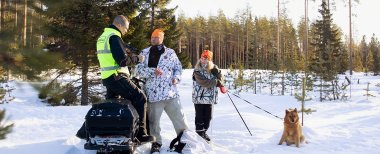Meeting a large carnivore
If you come across a large carnivore in the wild, keep calm. You should not shout or turn your back on the animal.
Seeing a large carnivore in the wild is very rare indeed, as the animals are very shy and with their keen senses they are able to steer clear of people. Photographing or filming large carnivores is not possible without hides and feeding spots. Nowadays nature photography and large carnivore tourism go hand in hand. Many nature photographers offer tourists the opportunity to see and photograph large carnivores for themselves.
Find photographs and videos of large carnivores and there way of living in different times of year in the Gallery.
Kuhmo Visitor Centre Petola is home to Finland's large carnivores. Petola gives a wealth of information about these predators, and photographs and videos play an important role in the exhibitions of the centre.
If you come across a large carnivore in the wild, keep calm. You should not shout or turn your back on the animal.
There are four large carnivore species in Finland, all belonging to different families. The lynx is a feline, the wolf is a canine, the brown bear is from the family Ursus and the wolverine is from the family of weasels. They have been classified as large carnivores based on their size and behaviour...

For the first time, Metsähallitus wilderness supervision has monitored the results of its work in real time throughout the year. The new system reveals that 368 people violated the law while in nature, and 169 people were caught without necessary permits.